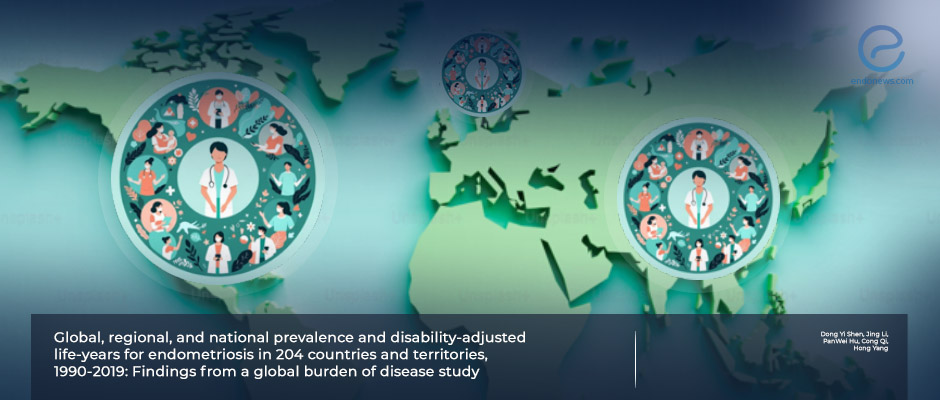Thirty Years of Endometriosis Burden Across 204 Countries
May 23, 2025
A global map of endometriosis burden, offering guidance for future health policies and interventions.
Key Points
Highlights :
- Endometriosis continues to be a significant public health concern.
- This study draws on 30 years of Global Burden of Disease (GBD) data to track global, regional, and national patterns of endometriosis prevalence and disability.
Importance :
- Understanding long-term, region-specific trends in endometriosis helps reveal disparities in diagnosis, healthcare access, and awareness.
- Such analyses can inform future public health strategies, particularly in regions with persistent underreporting or lack of diagnostic infrastructure.
What's done here:
- The authors have aimed to analyze the worldwide, regional, and intra-country burden of endometriosis and its trends from 1990 to 2019, via applying the latest data and improved methodologies from GBD 2019.
Main key features:
- The highest decline in endometriosis prevalence between 1990 and 2019 occurred in Central Latin America, with Guatemala showing the most marked reduction.
- A general inverse correlation was observed between Socio-Demographic Index (SDI) show a stronger downward trend in the Age-Standardized Prevalence Rate (ASPR) and endometriosis prevalence
- Regions with higher SDI scores showed a stronger downward trend in ASPR.
- The global peak in endometriosis prevalence was observed in women aged 25–29 years.
Strength and Limitations :
- The GBD 2019 provides a powerful, standardized tool for cross-regional epidemiologic comparison, enabling trend analysis over three decades.
- However, the absence of clinical subtype data (e.g., superficial, deep infiltrating, or ovarian endometriosis) limits disease-specific interpretation.
- Variability in healthcare systems, diagnostic capacity, and sociocultural attitudes toward menstruation may influence data quality and comparability.
- The study does not incorporate lifestyle, environmental, or dietary factors that could also affect disease prevalence across regions.
From the Editor-in-Chief – EndoNews
"This study provides a rare, large-scale view of how endometriosis affects women globally, and how that burden has shifted over the last thirty years. Its strengths lie in its methodological rigor, wide geographic scope, and its utility in public health planning.
While the data do not capture all clinical nuances of the disease, they offer a critical framework for addressing persistent gaps in awareness, diagnosis, and care—particularly in low-resource settings. A valuable contribution that brings endometriosis into the public health spotlight where it rightly belongs."
Lay Summary
A global epidemiological analysis by Zhao et al., recently published in the European Journal of Obstetrics & Gynecology and Reproductive Biology X, examined the burden and trends of endometriosis across 204 countries from 1990 to 2019 using the Global Burden of Disease 2019 dataset.
Endometriosis, which affects an estimated 5–10% of reproductive-aged women worldwide, contributes significantly to chronic pelvic pain, infertility, and diminished quality of life. However, global data on the condition have historically been limited and inconsistent. This study aimed to fill that gap by applying standardized GBD methodologies to assess age-standardized prevalence rates (ASPRs) and disability-adjusted life-years (DALYs) across global and regional populations.
The findings revealed an overall decline in the global burden of endometriosis, particularly in higher sociodemographic index (SDI) regions. The most pronounced reduction was observed in Central Latin America, with Guatemala showing the steepest national decline. Peak prevalence globally occurred between the ages of 25 and 29.
Despite these encouraging trends, the authors emphasize important limitations: the GBD does not differentiate between clinical subtypes of endometriosis (such as superficial peritoneal, ovarian, or deep infiltrating), and variations in diagnostic capacity, healthcare access, and cultural attitudes may influence the data’s completeness. Environmental, dietary, and lifestyle factors were also not included.
Nonetheless, this comprehensive analysis offers a crucial benchmark for policymakers, public health officials, and advocacy organizations seeking to raise awareness, improve diagnosis, and reduce the societal impact of endometriosis worldwide.
Research Source: https://pubmed.ncbi.nlm.nih.gov/39850250/
Endometriosis public health world-wide data GBD 2019 Washington University

